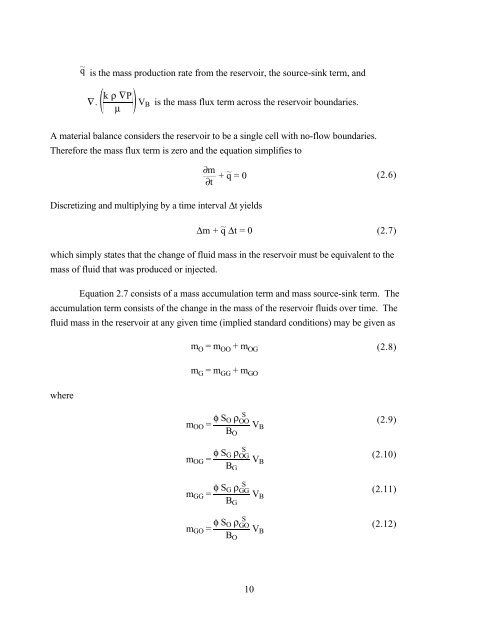multivariate production systems optimization - Stanford University
multivariate production systems optimization - Stanford University
multivariate production systems optimization - Stanford University
Create successful ePaper yourself
Turn your PDF publications into a flip-book with our unique Google optimized e-Paper software.
q is the mass <strong>production</strong> rate from the reservoir, the source-sink term, and<br />
∇.<br />
k ρ ∇P<br />
μ<br />
VB<br />
is the mass flux term across the reservoir boundaries.<br />
A material balance considers the reservoir to be a single cell with no-flow boundaries.<br />
Therefore the mass flux term is zero and the equation simplifies to<br />
∂m<br />
∂t<br />
Discretizing and multiplying by a time interval Δt yields<br />
+ q = 0 (2.6)<br />
Δm + q Δt = 0 (2.7)<br />
which simply states that the change of fluid mass in the reservoir must be equivalent to the<br />
mass of fluid that was produced or injected.<br />
Equation 2.7 consists of a mass accumulation term and mass source-sink term. The<br />
accumulation term consists of the change in the mass of the reservoir fluids over time. The<br />
fluid mass in the reservoir at any given time (implied standard conditions) may be given as<br />
where<br />
m O = m OO + m OG<br />
m G = m GG + m GO<br />
mOO = φ SO<br />
S<br />
ρOO BO<br />
mOG = φ SG<br />
S<br />
ρOG BG<br />
mGG = φ SG<br />
S<br />
ρGG BG<br />
mGO = φ SO<br />
S<br />
ρGO BO<br />
10<br />
VB<br />
VB<br />
VB<br />
VB<br />
(2.8)<br />
(2.9)<br />
(2.10)<br />
(2.11)<br />
(2.12)

















